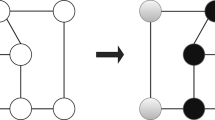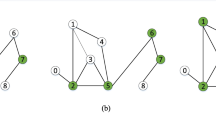Abstract
The minimum connected dominating set problem has garnered significant attention due to its wide applications in mobile ad hoc networks and sensor grids. As its variant, the minimum 2-connected dominating set (M-2CDS) problem plays a crucial role in fault-tolerant network design, with its importance increasingly prominent. To address the M-2CDS problem, this paper proposes an adaptive focal distance tabu search algorithm (AFD-TS). The algorithm employs a swap-based neighborhood structure paired with an efficient neighborhood evaluation method, enhanced by adaptive tabu strategies. It also incorporates several adaptive techniques, such as innovative diversification mechanisms, traceback strategies, and reverse approaches, all organized within a unique solution pool structure. To improve the efficiency, the algorithm applies two different optimization strategies and a fast maintenance for the set of cut vertices. Experiments were conducted on 37 public benchmark datasets. Results indicate that AFD-TS significantly reduced the running time in 12 instances while maintaining comparable performance in 15 ones. To verify the algorithm’s solving capability in large-scale complex scenarios, tests were further conducted on 34 newly generated instances. Experimental results demonstrate that the AFD-TS algorithm achieved leading performance across all new instances, fully proving its superiority in handling complex problems. Furthermore, this study conducted an analysis of the key components of the AFD-TS algorithm, comprehensively assessing the contribution of each module to the overall effectiveness of the algorithm, providing important basis for further optimization and improvement.
















Similar content being viewed by others
Data Availability
The large-scale dataset and the source code and executable files of the proposed algorithm have been made public at https://github.com/Yinwanglau/BD_BP_BA-DATASETS.
References
Kann V (1992) On the approximability of NP-complete optimization problems. Ph.D. thesis, Royal Institute of Technology Stockholm
do Forte VL, Lucena A, Maculan N (2013) Formulations for the minimum 2-connected dominating set problem. Electron Notes Discrete Math 41:415–422
Hopcroft JE, Tarjan RE (1973) Efficient algorithms for graph manipulation [h] (algorithm 447). Commun ACM 16(6):372–378
Abu-Khzam FN (2022) An improved exact algorithm for minimum dominating set in chordal graphs. Inf Process Lett 174:106206
Cai S, Hou W, Wang Y et al (2021) Two-goal local search and inference rules for minimum dominating set. In: Proceedings of the Twenty-Ninth International Conference on International Joint Conferences on Artificial Intelligence, pp 1467–1473
Lenzen C, Pignolet YA, Wattenhofer R (2013) Distributed minimum dominating set approximations in restricted families of graphs. Distrib Comput 26:119–137
Dholey MK, Sinha D, Mukherjee S et al (2020) A novel broadcast network design for routing in mobile ad-hoc network. IEEE Access 8:188269–188283
Kaur A, Singh G, Gupta R (2018) Limiting the excess broadcast in multipath routing using ant colony optimization. Int J Eng Technol 7(3.1):70–74
Omar N, Yaakob N, Farook RS et al (2018) A network coding-aware directional broadcast routing scheme for vanet. In: MATEC Web of Conferences, EDP Sciences, p 06012
Biswas J, Ray M, Sondur S et al (2019) Coordinated power management in data center networks. Sustainable Computing: Informatics and Systems 22:1–12
Pughat A, Sharma V (2015) A review on stochastic approach for dynamic power management in wireless sensor networks. Human-centric Comput Inf Sci 5(1):1–14
Li WL, Xie HJ (2015) The design of the power energy management system based on wireless sensor network. Appl Mech Mater 721:699–702
Khatiri A, Mirjalily G (2022) A cost-efficient, load-balanced and fragmentation-aware approach for deployment of vnf service chains in elastic optical networks. Comput Commun 188:156–166
Thangaraj J et al (2021) Multi-path provisioning in elastic optical network with dynamic on-request optimal defragmentation strategy. Opt Switch Netw 41:100607
Miladić-Tešić S, Marković G, Nonković N et al (2021) A metaheuristic approach for source traffic grooming in elastic optical networks. Trans Emerg Telecommun Technol 32(1):e4097
Wang W, Kim D, An MK et al (2012) On construction of quality fault-tolerant virtual backbone in wireless networks. IEEE/ACM Trans Netw 21(5):1499–1510
Wang F, Thai MT, Du DZ (2009) On the construction of 2-connected virtual backbone in wireless networks. IEEE Trans Wirel Commun 8(3):1230–1237
Morgan M, Grout V (2008) Finding optimal solutions to backbone minimisation problems using mixed integer programming. In: INC, pp 53–63
Buchanan A, Sung JS, Butenko S et al (2015) An integer programming approach for fault-tolerant connected dominating sets. INFORMS J Comput 27(1):178–188
Nutov Z (2018) Improved approximation algorithms for \(k\)-connected \(m\)-dominating set problems. Inf Process Lett 140:30–33
Shi Y, Zhang Y, Zhang Z et al (2016) A greedy algorithm for the minimum 2-connected \(m\)-fold dominating set problem. J Comb Optim 31(1):136–151
Jovanovic R, Bayram IS, Voss S (2016) A grasp approach for solving the 2-connected m-dominating set problem. arXiv preprint. arXiv:1609.05662
Jovanovic R, Voß S (2020) A matheuristic approach for solving the 2-connected dominating set problem. Appl. Anal. Discrete Math. 14(3):775–799
Luo M, Qin H, Wu X et al (2024) A novel local search approach with connected dominating degree-based incremental neighborhood evaluation for the minimum 2-connected dominating set problem. J. Comb. Optim. 47(5):72
Ahn N, Park S (2015) An optimization algorithm for the minimum \(k\)-connected \(m\)-dominating set problem in wireless sensor networks. Wirel. Netw. 21:783–792
Wu X, Lü Z, Galinier P (2017) Restricted swap-based neighborhood search for the minimum connected dominating set problem. Networks 69(2):222–236
Glover F, Lü Z (2021) Focal distance tabu search. Sci. China Inf. Sci. 64:1–12
Baswana S, Chaudhury SR, Choudhary K, et al (2016) Dynamic dfs in undirected graphs: breaking the o (m) barrier. In: Proceedings of the Twenty-Seventh Annual ACM-SIAM Symposium on Discrete Algorithms. SIAM, pp 730–739
Lucena A, Maculan N, Simonetti L (2010) Reformulations and solution algorithms for the maximum leaf spanning tree problem. Comput Manag Sci 7(3):289–311
Rossi RA, Ahmed NK (2015) The network data repository with interactive graph analytics and visualization. In: AAAI. https://networkrepository.com
Funding
The research was supported by the National Natural Science Foundation of China (Grant Nos. 62402164 and 62472149).
Author information
Authors and Affiliations
Corresponding author
Ethics declarations
Conflict of interest
The authors declare that they have no known competing financial interests or personal relationships that could have appeared to influence the work reported in this paper.
Additional information
Publisher's Note
Springer Nature remains neutral with regard to jurisdictional claims in published maps and institutional affiliations.
Rights and permissions
Springer Nature or its licensor (e.g. a society or other partner) holds exclusive rights to this article under a publishing agreement with the author(s) or other rightsholder(s); author self-archiving of the accepted manuscript version of this article is solely governed by the terms of such publishing agreement and applicable law.
About this article
Cite this article
Luo, M., Liu, X., Wu, X. et al. An adaptive focal distance tabu search approach for the minimum 2-connected dominating set problem. J Supercomput 81, 501 (2025). https://doi.org/10.1007/s11227-025-07014-2
Accepted:
Published:
DOI: https://doi.org/10.1007/s11227-025-07014-2




